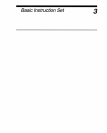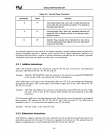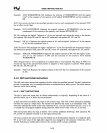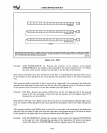
inter
BASIC INSTRUCTION SET
Table 3·2. Control Flags'
Functions
Bit Position Name Function
8
TF
Trap (Single Step)
Flag-Once
set, a single step interrupt
occurs after the next instruction executes.
TF
is cleared by
the single step interrupt.
9
IF
Interrupt-enable
Flag-When
set, maskable interrupts will
cause the
CPU
to transfer control to
an
interrupt vector-
specified location.
10
OF
Direction
Flag-Causes
string instructions to auto deere·
ment the appropriate index registers when set. Clearing
OF
causes auto increment.
An arithmetic operation may consist of
two
register operands, a general register source operand with a
memory destination operand, a memory source operand with a register destination operand, or an
immediate field with either a register or memory destination operand, but not
two
memory operands.
Arithmetic instructions can operate
on
either byte or
word
operands.
3.3.1 Addition Instructions
ADD (Add Integers) replaces the destination operand with the sum of the source and destination
operands. ADD affects
OF, SF, AF, PF, CF, and ZF.
Example: ADD BL,
BYTEOPRND. Adds the contents of the memory byte labeled BYTEOPRND
to
the contents of BL, and replaces
BL
with the resulting sum.
ADC
(Add Integers with Carry) sums the operands, adds one if
CF
is
set, and replaces the destination
operand with the result. ADC can be used
to
add numbers longer than
16
bits.
ADt
affects OF, SF,
AF, PF, CF, and ZF.
Example: ADC BX,
Cx.
Replaces the contents of the destination operand
BX
with the sum of
BX,
. CS, and 1 (if CF
is
set).
If
CF
is
cleared, ADC performs the same operation
as
the ADD
instruction.
INC
(Increment) adds one
to
the destination operand. The processor treats the operand
as
an
unsigned
binary number.
INC
updates AF, OF, PF, SF, and ZF, but it
does
not affect CF.
Use
ADD with an
immediate value of 1 if an increment that updates carry (CF)
is
needed.
Example:
INC
BL. Adds 1 to the contents of
BL.
3.3.2
Subtraction Instructions
SUB
(Subtract Integers) subtracts the source operand from the destination operand and replaces the
destination operand with the result.
If
a borrow
is
required, carry flag
is
set. The operands may be
signed or unsigned bytes or
words.
SUB affects OF, SF, ZF, AF, PF, and CF.
3-7


















